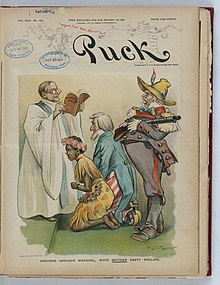Shotgun wedding
This article needs additional citations for verification. (July 2017) |
A shotgun wedding is a wedding which is arranged in order to avoid embarrassment due to premarital sex which can possibly lead to an unintended pregnancy.[1] The phrase is a primarily American colloquialism, termed as such based on a stereotypical scenario in which the father of the pregnant bride-to-be threatens the reluctant groom with a shotgun in order to ensure that he follows through with the wedding.
Rationale[]
One purpose of such a wedding can be to get recourse from the man for the act of impregnation; another reason is trying to ensure that the child is raised by both parents. In some cases, as in early America and in the Middle East, a major objective was restoring the social honour of the mother. The practice is a loophole method of preventing the birth of illegitimate children, or if the marriage occurs early enough in the gestation period, to conceal the fact that conception had already occurred prior to marriage.
In some societies, the stigma attached to pregnancy out of wedlock can be enormous, and coercive means (in spite of the legal defense of undue influence) for gaining recourse are often seen as the prospective father-in-law's "right", and an important, albeit unconventional, coming of age event for the groom and young father-to-be.[citation needed] Often, a couple will arrange a shotgun wedding without explicit outside encouragement, and some religious groups consider it a moral imperative to marry in that situation.[2]
By culture[]
Middle East[]
This section does not cite any sources. (August 2018) |
Premarital sexual relations remain taboo across all social strata throughout the Arab world. In many cases, fornication is illegal and even a criminal offence under Sharia law. Even when it is not, the social response can be extreme, especially against women who have lost their virginity prior to marriage.
In Arabic culture, shotgun weddings serve to obscure the fact that a baby was conceived prior to marriage. When that proves impossible, the social standing of the couple involved is irreparably damaged. Nevertheless, shotgun weddings help prevent the individuals involved, especially the women, from becoming social pariahs.
Apart from instances of regional slang, there is no universal, specific term for "shotgun weddings" in Arabic. This is because they are not recognised as a regular social phenomenon and because a successfully conducted Middle Eastern shotgun wedding is generally unknown to the guests. In some Arabian Gulf nations, the term "police station marriage" (Arabic: زواج مخفر) may be the closest colloquial analogue for the concept of a "shotgun wedding".
East Asia[]

- In Japan, the slang term Dekichatta kekkon (出来ちゃった結婚), or Dekikon (デキコン) for short, emerged in the late 1990s. The term can literally be translated as "oops-we-did-it-marriage", implying an unintended pregnancy. Notable celebrities with these marriages include Namie Amuro, Takako Uehara, Yōko Oginome, Hitomi Furuya, Ami Suzuki, Kaori Iida, Nozomi Tsuji, Anna Tsuchiya, Meisa Kuroki, Leah Dizon, Melody Miyuki Ishikawa, Riisa Naka, Rie Miyazawa and Emi Takei.[3][4] A quarter of all Japanese brides are pregnant at the time of their wedding, according to the Health Labor and Welfare Ministry,[5] and pregnancy is one of the most common motivations for marriage.[6] The prevalence and celebrity profile of dekichatta-kon has inspired Japan's wedding industry to introduce an even more benign phrase, sazukari-kon (授かり婚, blessed wedding).[7]
- In China, the term 奉子成婚 (pinyin: Fèngzǐchénghūn; lit. 'married by the order of child') means that the couple married because conception occurred outside of marriage. It is a pun on the phrase 奉旨成婚, pronounced Fengzhichenghun and implying that a wedding is approved by imperial edict. It is becoming increasingly common among China's youngest generation. However, in the same age group, there is objection and criticism to such a practice.[8][9]
- In Korea, the slang term 속도위반 (RR: Sokdowiban; literally: "speeding over the limit") refers to the situation in which the pregnancy preceded the marriage.[citation needed]
- In Vietnam, the term "Bác sĩ bảo cưới" (literally meaning "because [the] doctor said so") is often used with humorous intention.[citation needed]
Southeast Asia[]
This section does not cite any sources. (August 2018) |
- The Philippines has a shotgun wedding tradition (Tagalog: pikot) where a man is forced to marry a woman he impregnates. Variants of this practise include a woman's parents forcing marriage to their daughter due to her social status or wealth (rather than his desire to marry her). Weapons may or may not be used in coercion, but other means include litigation, particularly when the woman's family threatens to file rape charges against the man.
- Indonesia has a similar condition with the Philippines; this is usually called "married by accident".
Europe[]
Because of the sexual revolution beginning in the 1960s, the concepts of love, sexuality, procreation and marriage began to separate after being intimately entangled in social consciousness for centuries.[10] However, sexual practice had not always followed social convention, resulting in shotgun or Knobstick weddings.
- In the United Kingdom, one source reports that almost 40% of all brides were pregnant in 1850.[11]
- In Denmark, a 1963 study found that 50% of all brides were pregnant.[10]
- In the Netherlands and Belgium, the Dutch term moetje was a commonly used euphemism for marriage resulting from unintended pregnancy. The noun is formed from imperative of the verb moeten ("must", "to have to") with the added suffix -je, indicating a diminutive. Thus, it might be translated as a "little must" or a "little you-have-to", i.e. one is compelled to marry to avoid the shame of giving birth out of wedlock.
Moetjes were a common occurrence in Belgium and the Netherlands until the first half of the 20th century. In the early 1960s, about a quarter of all marriages in the Netherlands were shotgun marriages; however, in some areas, up to 90% of the brides were pregnant.[10] By the late 2000s, the practice had become so rare that the term was growing obsolete.[12] According to a 2013 by the Centrum voor Leesonderzoek, the word moetje was recognised by 82.5% of the Dutch and 43.1% of the Flemish.[13]
North America[]
This section does not cite any sources. (August 2018) |
- In the United States, the use of duress or violent coercion to marry is no longer common, although many anecdotal stories and folk songs record instances of such coercion in 18th- and 19th-century America. The phenomenon has become less common as the stigma associated with out-of-wedlock births has declined and the number of such births has increased. Effective birth control and legalized abortion have also resulted in fewer unplanned pregnancies carried to term. Nonetheless a marriage which occurs when the bride is pregnant, even when there is no family or social pressure involved, is still sometimes referred to as a "shotgun wedding".
In popular culture[]

Films[]
- Acht Mädels im Boot (1932), German musical film
- Eight Girls in a Boat (1934), American feature film, refilming of Acht Mädels im Boot
- Seven Brides for Seven Brothers (1954)
- Jenny, first Dutch fullcolour feature film,[10] refilming of Acht Mädels im Boot
- A Kind of Loving (1962), British feature film[10]
- Girl with Green Eyes (1964), Irish feature film[10]
Books[]
- The Lonely Girl (1962), Irish novel on which Girl with Green Eyes is based[10]
TV Shows[]
- The Simpsons, where Homer married Marge when she was pregnant with Bart.
- King of the Hill, where Lucky Kleinschmidt married Luanne Platter when she was pregnant with Gracie.
- Fated to Love You, a Taiwanese (ROC) 2008 TV Series where a poor secretary gets pregnant with an heir of a toiletries company. A Korean (ROK) remake of this drama with the name You Are My Destiny was also made.
See also[]
- Cohabitation
- Forced marriage
- Knobstick wedding
- Marry-your-rapist law
- Premarital sex
- Oklahoma!, a play where one character, Ali Hakim, is forcibly coerced towards marriage on two occasions.
- Marriage of convenience
References[]
- ^ "the definition of shotgun wedding". Dictionary.com. Retrieved 2016-12-11.
- ^ "Deuteronomy 22:28-29". BibleGateway. Retrieved 2019-01-10.
- ^ Haruna Kashiwase, "Shotgun Weddings a Sign of the Times in Japan," Population Today, July 2002, prb.org Archived 2012-10-25 at the Wayback Machine
- ^ "Japan embraces shotgun weddings". Telegraph. June 22, 2009. Retrieved July 25, 2010.
- ^ Brasor, Philip (8 January 2012). "Oops! Pregnant celebs dancing down the aisle". The Japan Times. Retrieved 13 January 2016.
- ^ National Institute of Population and Social Security Research, The Fourteenth Japanese National Fertility Survey in 2010 (October 2011). "Marriage Process and Fertility of Japanese Married Couples" (PDF). Retrieved 13 January 2016.
- ^ Ryall, Julian (22 June 2009). "Japan embraces shotgun weddings". The Telegraph. Retrieved 13 January 2016.
- ^ 奉子成婚成常現象 "大肚新娘"挑戰傳統貞操[permanent dead link] Married by the child became a norm, "Pregnant brides" are challenging the traditional chastity.
- ^ “奉子成婚”挑战传统道德底线 Archived 2015-06-10 at the Wayback Machine "Married by the Child" challenging traditional marital limits.
- ^ Jump up to: a b c d e f g Buelens, Geert (2018). De jaren zestig: Een cultuurgeschiedenis. Amsterdam: Ambo/Anthos. p. 115. ISBN 9789026329500. Retrieved 20 May 2018.
- ^ Faramerz Dabhoiwala (2012). The Origins of Sex: A History of the First Sexual Revolution. Oxford University Press. ISBN 978-0199892419. Quoted at [1]
- ^ Noordman, Joannes Maria Antonius; Rietveld-van Wingerden, Marjoke; Bakker, Petronella Catharina Maria (2008). Vijf eeuwen opvoeden in Nederland. Assen: Uitgeverij Van Gorcum. p. 286. ISBN 9789023246138. Retrieved 20 May 2018.
- ^ Woordenkennis van Nederlanders en Vlamingen anno 2013, p. 679. Centrum voor Leesonderzoek.
- Forced marriage
- Weddings in the United States